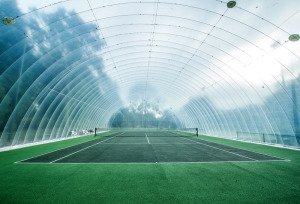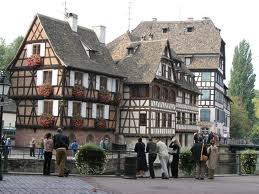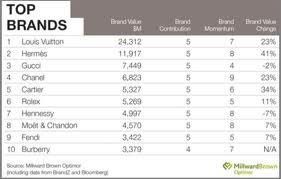Facilities to forward your tennis career!
Coming from UK, tennis was an all year round sport. No surprise in this you might think. The professional game is a year round sport, with a hall season, and an outdoor season. The only problem is, we didn't have a hall. It didn't stop our local leagues having a full winter programme, with all those who played in summer, also playing in winter. In fact, I'd swear there were some players who didn't play that much in summer because there were other alternatives in summer, cricket, athletics, sailing etc. We went outside in winter to play tennis.
I'm no softie, and, at that time, neither were my compatriots. So the winter matches went ahead, and afterwards everyone huddled up in the clubhouse with hot mugs of tea, a bar heater and spare blankets. It was rather quaint, and totally fitting of the British reputation of tennis being largely a social sport. The match beforehand was to get a bit of fresh air. There was much sport around standing around in tracksuit bottoms, glove and a couple of pullovers. If you know the south coast climate well, you may also know that a rainy, blowy day of 12 ° C can just as easily occur in July as in January. The weather hardly changes. Hardly any extremes, and always a bit of unpleasantness around the corner.

Hall tennis
My first experience of a tennis hall wasn't until 1986 when I took my USPTR exam down at Hayne Barn. It was a bubble over tarmac courts. The course and exam all took place in the bubble, which I found a thrill, because we used lots of videos, and verbal noise, and the bubble made it very cosy. Ironically the weather was great that weekend, and I remember wishing that we could play outside in the sun! We weren't there to play, we were there to learn.
That is the first main point. To learn tennis, you need good practice partners. These are found in a certain type of facility.
I'd say that putting a roof on is essential. It takes the weather out of the equation. I hear a clamour of shouts! But you've got to learn to play outside. Indeed you do, but for most exercises that you do, it is a great help to NOT have to deal with the weather. It improves the value of most exercises enormously.
There is the other aspect - money. When you have a hall, you know that a lesson is always going to go ahead. You don't have to do last minute phone calls to check on conditions. Golden Rule Number One - find a hall.
There are two types of hall in UK. First, those affiliated, or belonging to, the major tennis centre chains like David Lloyd centres. They are expensive money-making operations which live as much from fitness rooms, restaurants, and a range of sports, than tennis itself. I'm fairly sure that tennis operations are largely non-profitable. However, the facilities are usually excellent. The courts don't need to be heated in winter, so running court costs are reasonable. Land prices are exorbitant in UK, so the real problem is membership fees. You can spend hundreds of pounds just for membership, before you have even ticked any boxes for your sport choices.
One great thing is that these halls have now become Performance academies. That is, there are groups of young players playing at these centres full-time, taking up court space in daytime when not much is going on. They also pay a few thousand pounds per year for training and court time. A lot of these players have to move from their home and then rent a flat nearby, also expensive in UK. A typical price would be £15,000 per year. In that price you haven't yet paid for your tournaments, travel, food and utility charges. A lot of these "squad" players are reluctant to travel away to tournaments because of the costs, the futility, expense and complexity of so many British tournaments, and the loss of training time at their "squad" centre. These "squads" first boomed twenty years ago. I still haven't heard of a single British player to become a professional through this system. Golden Rule Two. Don't do squads.
The second type of hall is a private one. It may or may not have squads depending on available accommodation, access and reputation. Squads don't really make money, and are tricky to run. There is a lot more value in keeping older people on the court in day time, and regular groups of children. Therefore you may find some good players playing at such centres, but they are more sparse, and less ambitious. It is very difficult to practise effectively in such a centre.

In Germany this second type is the norm. Trainers, with or without contract with the hall owner, organise lessons, often all year round, in order to profit from perfect conditions, and an uninterrupted sure spot. You won't find any good players in such halls.
So where are the good players in Germany ? They are in the clubs. I learned a great deal by working in Germany. The club system really works. Nearly all of the professional players produced by Germany have been affiliated to clubs, being paid for by private sponsors to play matches, direct social functions and give lessons. Facilities are impeccable, outside and inside. Although the seasons are unfortunately very separated administratively, and competitively, the players train hard all year round and to a point profit from a year with periods of forced absence from competition, or from availability of practice partners. In most German clubs you can find great practice partners all year round. A lot of foreigners come to Germany too in summer. They teach at clubs, get paid for matchplay in May and June, and go on World Ranking point harvest in the other months. Germany has plentiful tournaments at this level. There are one or two squads in Germany, but they are run by ex-professionals or world-class trainers and are very expensive. They definitely bring players onto the World Ranking lists, but they are expensive.
French branding

In France, there are very few private halls. Some of them are school + tennis facilities for young players; some are rich country type faicilites for the richer levels of society. The vast majority are halls that belong to the town council. They aren't in great condition, have dilapidated ancillary services, but they are plentiful and incredibly cheap. An annual subscription, play as much as you like will cost you €150 per year! The only problem is that in this sort of facility there aren't any good players. There is a huge exodus of good players from poorly-performing clubs to the bigger regional centres in the bigger towns. There you can find better facilites, some coaches, and still get court time. They are fractionally more expensive.
The vast majority of French professional players come from the Pole Espoir system. It really works. These are players spotted at a young age by the pros all around the country, and invited, mostly at Federation cost, to a Regional Centre with the most experienced Federation coaches, and half the day you are at school. Tournaments, cheap and accessible, and good level, are available all year round. You can conceive a great circuit in France around your practice periods with great ease. Golden Rule Number Three - for at least one part of your tennis development, come and play in France.
Have A Great Story About This Topic?
Do you have a great story about this? Share it!
Tour Coach -
on this site!
